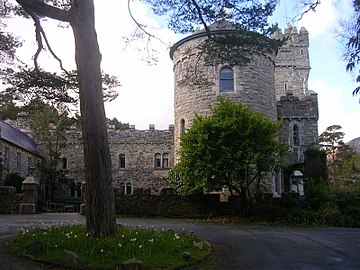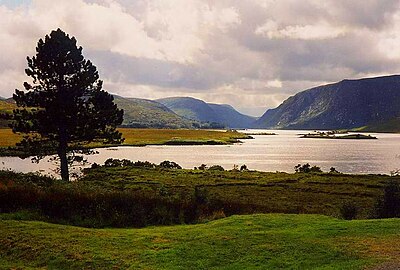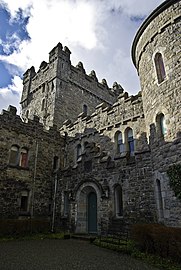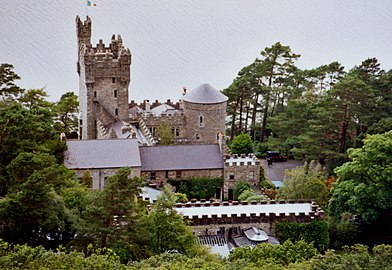Glenveagh Castle
| Glenveagh Castle | |
| County Donegal | |
|---|---|
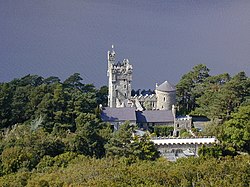 Glenveagh Castle | |
| Location | |
| Grid reference: | C02062095 |
| Location: | 55°2’10"N, 7°58’7"W |
| History | |
| Built c. 1870 | |
| Country house | |
| Baronial | |
| Information | |
| Owned by: | Heritage Ireland |
Glenveagh Castle is a large, castellated mansion house in County Donegal, built in about 1870.
The castle stands teetering on the edge of Lough Beagh in the heart of the county. It is within the boundaries of Glenveagh National Park, near both Churchill and Gweedore. The house is built in the Scottish Baronial style and consists of a four-story rectangular keep, surrounded by a garden, and a backdrop of some 40,873 acres of mountains, lakes, glens and woods complete with a herd of red deer.
The name is form' the Irish Gleann Bheatha (Bheithe) which means "Glen of the Birch Trees".
The visitor centre has displays that explain the park as well as an audio-visual show and is accessible for patrons with disabilities.
Contents
History
Glenveagh Castle was built between 1870 and 1873 by Captain John George Adair.
The castle was built by Captain John George Adair (1823-1885), a native of County Laois, and a member of the minor gentry. Adair had made his fortune by land speculation in the United States, and he returned to Ireland and bought up vast tracts of land in Donegal. Adair had married in 1869, Cornelia Wadsworth Ritchie, a daughter of James S. Wadsworth, a Union General in the American Civil War. Together they set about the creation of the gardens and castle.
Adair's ambition was to create an estate and castle that surpassed Balmoral, Queen Victoria's Highland retreat. John Adair is remembered with scant affection in Donegal: on the heels of the Great Irish Famine and the mass emigration which followed, John Adair evicted 224 tenants from their blackhouses : these tenant clearances have passed into history and folklore, ballad and documentary.
The Derryveagh Evictions, as they are known, resulted from a dispute that blew up soon after Adair purchased Glenveagh and Gartan in 1859, making an estate of 28,000 acres. A row between the tenants and Adair over shooting rights and trespassing sheep culminated in the murder of his Scottish steward James Murrog. Consequently, Adair carried out his threat to evict the tenancy. On 3 April 1861, a considerable cortege of 200 police, three sub officers, the resident magistrate and the sub-sheriff set out from Letterkenny to undertake their duties. The evictions began at Lough Barra where a widow, Mrs Hanna McAward and her six daughters and one son were the first to suffer. The work of destruction continued for three days through Magerashangan, Staghall, Claggan, Ardator and Castletown among other townlands. In all, 44 families were evicted making a total of 244 persons.
Many of the evicted went to the work house in Letterkenny, others were helped by locals and the clergy also raised money. In Australia, the Donegal Relief Fund was revitalized and arrangements were made to help the young people aged between 16 and 28 years to emigrate. Many took advantage of the scheme. As they settled in Sydney the strong oral tradition ensured that the descendants remembered their families' bitter memories.
After John Adair′s death in 1885, his widow Cornelia Adair (1837–1921) assumed ownership. She lived part of the time at Glenveagh Castle, and, unlike her late husband was popular. She improved the beauty of the castle grounds and was considerate of the townspeople. The Adairs had no children to succeed them.
The Duke and Duchess of Connaught were guests of Mrs Adair in September 1902.[1]
Henry Plumer McIlhenny of Philadelphia purchased the estate in 1938, having rented it during the summer months since 1933. McIlhenny left the gardens and castle to the Irish nation in the 1970s, so that Glenveagh National Park could be created, but continued to use the castle as a part time residence until 1982.
Pictures
Outside links
| ("Wikimedia Commons" has material about Glenveagh Castle) |
- Glenveagh Castle Gardens
- Glenveagh Castle in Donegal
- Glenveagh Castle and Gardens
- Glenveagh Castle - Donegal's Camelot
- Glenveagh Heritage Site
- The Derryveagh Evictions
- Coillte: Glenveagh Woods
References
- ↑ The Times: Court Circular, Tuesday 23 September 1902 page 7; issue 36880
